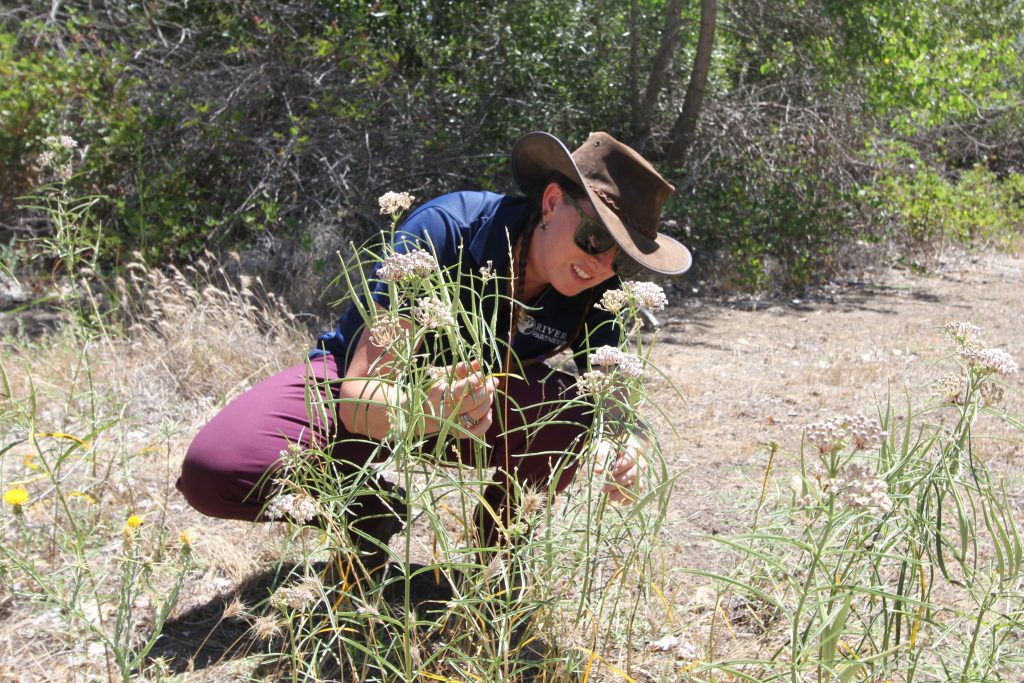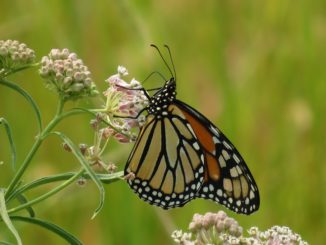
On a recent Friday afternoon, the heat more intense than the thermometer would indicate, Angela Laws headed into a clearing at the Oroville Wildlife Area. She checked her handheld GPS, then strode past rows of plantings until locating her quarry: a narrow leaf milkweed plant. Squatting, she carefully examined each stalk and noted her observations.
Laws, a biologist with the Xerces Society for Invertebrate Conservation, had come to Oroville seeking signs of monarch butterflies. She joined biologist Kim Armstrong of Chico-based River Partners, plus two interns, at the site of a habitat restoration conducted by their organizations and others. They conducted the second of three counts this summer to log progress—vibrance of the milkweed and presence of butterflies.
As the CN&R reported a year ago, the population of western monarchs had declined 99.9 percent since the 1980s; only around 2,000 were observed in 2020 during annual overwintering count along the Pacific coast. (Just this week, the International Union for the Conservation of Nature added the monarch to its endangered list.)
River Partners secured a $1.2 million state grant to restore 595 acres over eight sites statewide. At the Oroville Wildlife Area (OWA), the group planted 1,500 irrigated milkweeds.
This winter, about 250,000 monarchs were observed on the coast.
That 125-fold increase obviously represents success, and the OWA has proven especially vital. Armstrong found six monarch caterpillars during an Oroville visit in May and a butterfly in June; Laws, who has toured the eight sites twice, said she consistently finds more butterfly species at Oroville than the others.

Breadth of life is important, too. The restoration focuses on monarchs—for good reason, being what Armstrong calls “an iconic keystone species” and “a really good indicator for problems in the ecosystem”—but the milkweed benefits a spectrum of pollinators as well as animals, such as birds, that feed on these insects.
Turns out, the monarch project is having a butterfly effect.
“Because plants and insects are so near the bottom of the food web, when you’re doing this sort of restoration, you’re going to affect many other species than just monarchs,” Laws said during a break in the count. “They’re going to be impacted in positive ways when we do this type of work.”
That’s not to diminish the impact on monarchs, though. Laws said project researchers have seen the butterflies at three of the sites where they weren’t last year, including OWA. Southern California has year-round populations, she explained, while monarchs migrate through the Sacramento Valley twice annually.
“That’s why it’s important to have this habitat here,” she continued, “and the monarchs are finding it.”
Cautious optimism
Monarchs hit the verge of extinction for multiple reasons—climate change, pesticides, land use—that essentially distill to habitat. The butterfly eats only milkweed and lays eggs under the leaves. With development supplanting farmland and weedkillers proliferating, monarchs and other native pollinators have lost their nectar source.
River Partners, which mounts a range of habitat restorations, teamed with other nonprofits (e.g., the Xerces Society) and public agencies (e.g., California Department of Fish and Wildlife) to reverse the decline. The project incorporates milkweeds into acreage of native plantings.
Growth varies. At the OWA site, on rocky terrain through the southern end of the nature preserve, only hardy species—weeds, mostly, and deeper-rooted trees—survive. Showy milkweeds, distinguished by their broad leaves and their blossoms, tower over most of the plantings. By contrast, at River Partners’ Bidwell-Sacramento River State Park restoration, with richer soil, narrow and showy milkweeds thrive amid rows of elderberries and myriad other lush plants.

Armstrong, who works out of Chico, checks on the North State sites more frequently than Laws, who works out of Sacramento. They met up at OWA on July 8 and will conduct their final count there in August. Both expressed enthusiasm about the monarch numbers … and caution.
“It’s a huge increase; it’s hopeful,” Laws said. “It shows these animals do have the capacity to recover, so if we do continue these restoration and conservation efforts, we can be successful in saving western monarchs.
“We’re not out of the woods yet. This was just one year; we want to see sustained growth over time. And in the 1980s, there were millions of monarchs along the coast. We have a long way to go.
“But what this shows is that it can be done.”
The precipitously low level frightened conservation biologists such as Laws because a “freak event” such weather or a disaster could wipe out the species. The population jump provides a bit of a buffer.
Why did it happen?
“It’s hard to say there was one thing that was more important than the other in leading up to the increase,” Laws said. “I think we don’t know yet, but certainly we know that continuing to restore habitat, reducing pesticide use, those sorts of things, are going to continue to benefit monarchs and other pollinators in California.”
Counterintuitively, dry conditions may have helped. Laws, citing research from UC Davis professor Arthur Shapiro, said “monarchs and butterflies in the valley tend to do better during drought years, at least during the first few years of drought. It’s not exactly clear why, but you can see that native plants like milkweed are drought tolerant.”
In the long run, however, Shapiro and other researchers have found climate change detrimental. Laws said western butterfly populations have dropped 1.4 percent a year over 40 years—“that’s a huge decline over time.” One of the leading factors is increased temperatures in the fall.

At OWA, River Partners added milkweed to an existing, irrigated restoration two years ago. That was the first of the eight locations planted; not all have irrigation. Milkweed already grew at the Oroville preserve—the biologists monitor a spot, known as the control site, where narrow leaf plants sprout naturally.
“This project was set up as an experiment,” Armstrong said by the edge of the glen. “At those sites [without irrigation] where we didn’t get a lot of rain … we haven’t had a whole lot of success yet. So it’s been a real challenge for us, and it’s just going to become more of a challenge with climate change and also water in California.”
Nurturing nature
Laws has been particularly encouraged by what she’s seen in Oroville. The second count yielded no monarchs, though both biologists identified marks on stems indicating milkweed activity. But Laws came across seven other butterfly species—double what she’s been finding at the other sites.
Midday, Armstrong pointed out a buckeye and caught in her net a hairstreak butterfly. Native bees and flies buzzed around the tiny flower heads of narrow leaf milkweeds. The pink blossoms of showy milkweeds invited more pollinators.
“Many species of butterfly have host plant requirements, and some of those are out here,” Laws said, naming buckwheat as a plant intentionally seeded in the restoration. “There are many butterflies that would benefit from this. And, of course, all the nectar that’s available.

“If it was all just dead invasive grasses, there wouldn’t be any resources available for any [pollinator] to use in a degraded habitat like that. I think it is indicative of success when you start seeing more butterflies, more individuals of each species—that shows things are going well.”
Armstrong noted songbirds in the surrounding treeline. They and other avians are among the insectivores whose survival interconnects with the project. In that way, Laws added, “by creating habitat for monarchs, we’re creating habitat for many other species.”
Another good omen is several milkweeds at OWA have spawned new plants. Their seeds, dispersed by the wind much like a dandelion’s, took root and sprouted. Armstrong has not observed similar spread at the river site, which was planted a half-year later, “but likely it will have the same result.”
Conservationists do not expect restoration projects alone to reverse the decline in monarchs. They press legislation and litigation against pesticides. They lobby elected leaders.
Despite the recent international designation, the U.S. has yet to recognize monarchs under the Endangered Species Act. However, in June, multiple government and conservation agencies did convene for the first ever Monarch Butterfly Summit, at which the U.S. Department of the Interior awarded $1 million to the Monarch Butterfly and Pollinators Conservation Fund and the U.S. Fish and Wildlife Service committed to opening a national Pollinator Conservation Center.
In addition their own habitat efforts, conservationists promote participation by their neighbors.
The Xerces Society, for one, has plant lists to guide homeowners in replacing lawns and garden patches with natives such as California nectar plants for monarchs. While River Partners expands habitat annually, nearly tripling the North State footprint with a 300-acre project near Redding, residents could compound growth exponentially.
“It reduces your water bill while providing habitat,” Armstrong said. “That’s a good one.”
An earlier version of this feature was edited to include news about monarch butterflies being recently listed as endangered, as well information on the national Monarch Butterfly Summit that took place in June.


I have been raising monarchs for 4 yrs now in my 14×14 garden.it is shaped like a butterfly.usually about 130 released each yr.
That sounds wonderful, Gary! I’d like to do something similar. What would be your recommendation as to how to start?
I just released 6 monarchs from my little netting pop up I call a butterfly cloud. I have 4 more monarchs that will emerge today and another in a “J” position. Last summer I lost all 32 caterpillars save 1 from a parasite. This year my “cloud” seems to be helping. I love checking for eggs/caterpillars and chrysalis everyday. It is one of my greatest pleasures.